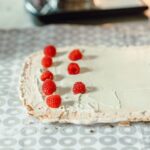Are you wondering “what is the best frosting for cake decorating“? The right frosting can make or break a beautifully decorated cake. In this article, we’ll explore different types of frosting and their suitability for cake decorating. From classic buttercream to rich ganache and versatile fondant, we’ll discuss the characteristics and uses of each type of frosting.
Choosing the right frosting for cake decorating is crucial in achieving the desired look and taste for your cakes. Whether you’re looking for a smooth finish, flavorful tang, or intricate designs, there’s a perfect frosting for every cake decorating project. We’ll delve into popular options such as buttercream, cream cheese, whipped cream, ganache, and fondant frostings. Each type offers unique qualities that cater to different preferences and techniques in cake decorating.
As we explore each type of frosting, we’ll provide tips on achieving the perfect consistency, flavor pairings, and methods for creating stunning decorations. Additionally, we’ll discuss ways to overcome common challenges in using different types of frosting for cake decorating. By the end of this article, you’ll have a comprehensive understanding of various frostings and be empowered to experiment with different options to find the best fit for your cake decorating projects.
Buttercream Frosting
Achieving the perfect consistency and texture for buttercream frosting is crucial for successful cake decorating. To ensure that the frosting is easily spreadable and pipe-able, it is important to properly cream the butter and incorporate the powdered sugar gradually. Adding a small amount of milk or cream can also help achieve the desired texture for easy application on the cake.
When considering what is the best frosting for cake decorating, buttercream certainly stands out due to its versatility and ability to take on different flavors. Whether it’s classic vanilla, rich chocolate, or even vibrant fruit flavors, buttercream can be easily customized to complement various cake flavors. Furthermore, the smooth surface of buttercream provides an excellent canvas for any additional decorations or embellishments that may be added to the cake.
In addition to its aesthetics, buttercream frosting also offers a delectable taste that complements a wide range of cake flavors. Its sweet and creamy profile enhances the overall flavor experience, making it a popular choice among both bakers and consumers alike. With proper technique and attention to detail, buttercream frosting can elevate any cake decorating project to new heights.
Cream Cheese Frosting
When using cream cheese frosting for cake decorating, it is important to ensure that the consistency is firm enough to hold its shape when piped onto the cake. To achieve this, it’s recommended to start with chilled or slightly cold cream cheese and butter when making the frosting.
This will help prevent the frosting from becoming too soft or runny, especially in warm temperatures. Additionally, adding confectioners’ sugar in small increments can help maintain the stability of the frosting while providing a smooth texture for piping and spreading.
In terms of flavor pairings, cream cheese frosting works well with a variety of cake flavors, including red velvet, carrot, pumpkin spice, and banana. Its tangy taste complements the sweetness of these cakes beautifully.
For those who prefer a less sweet option for their cake decorating projects, cream cheese frosting provides a balanced level of sweetness without being overpowering. With its versatility and delicious flavor profile, cream cheese frosting remains a popular choice for cake decorators looking to add a delectable touch to their creations.
Whipped Cream Frosting
Achieving the perfect stability and texture for whipped cream frosting is essential for successful cake decorating. Here are some tips for stabilizing whipped cream frosting:
- Use cold utensils and bowls to whip the cream, as warmth can cause it to lose its structure.
- Add a stabilizing agent, such as gelatin or cornstarch, to help maintain the fluffy consistency of the whipped cream.
- Avoid over-whipping the cream, as this can result in a grainy texture and make it challenging to work with when decorating cakes.
When using whipped cream frosting for intricate cake designs, it’s important to consider its delicate nature. For more elaborate decorations, it’s recommended to create a firmer whipped cream by adding less liquid or incorporating additional stabilizers. By mastering the art of stabilizing and working with whipped cream frosting, decorators can achieve beautiful and elegant cake designs that are sure to impress.
In addition to its versatility in decorating, whipped cream frosting also offers the benefit of being easily flavored and colored. Incorporating extracts, citrus zests, or even melted chocolate into the whipped cream allows decorators to personalize their creations with unique tastes and visual appeal. With so many possibilities for customization, whipped cream frosting is a popular choice among both professional bakers and home decorators looking for a lighter alternative.
Ganache Frosting
When it comes to cake decorating, one of the most luxurious and indulgent frosting options is ganache. Known for its rich and glossy appearance, ganache is a versatile choice for decorating all kinds of cakes. Whether you’re aiming for a sleek and modern look or intricate designs, ganache provides a stunning finish that’s sure to impress.
Rich Flavor and Glossy Appearance
Ganache is made from just two ingredients: chocolate and heavy cream. The combination of these simple ingredients creates a frosting with an incredibly rich flavor and a smooth, glossy appearance. When spread onto a cake, ganache creates a decadent sheen that is perfect for special occasions and events.
Best Methods for Using Ganache in Cake Decorating
When using ganache for cake decorating, it’s important to achieve the right consistency. This can be achieved by adjusting the ratio of chocolate to cream and allowing the mixture to cool to the desired thickness before use. Ganache can be poured over cakes for a smooth finish, or whipped into a fluffy texture for piping intricate designs. Additionally, ganache can also be used as a base layer underneath fondant to provide added flavor and moisture to the cake.
Tips for Decorating With Ganache
To ensure successful cake decorating with ganache, it’s important to work quickly but carefully as ganache sets relatively quickly once applied to the cake. For more elaborate decorations, chilling the frosted cake briefly can help keep the ganache in place while working on intricate designs or adding additional decorations such as edible flowers or sprinkles. Experimenting with different types of chocolate (dark, milk, white) can also provide unique flavors and visual appeal when using ganache for cake decorating.
Ganache offers both versatility and elegance in cake decorating-making it an excellent option for those looking to create showstopping desserts that are both visually stunning and delicious in flavor.
Fondant Frosting
When working with fondant frosting for cake decorating, it is important to keep in mind the following tips:
1. Kneading: Before rolling out fondant, knead it until it becomes smooth and pliable. This will help prevent cracking when covering the cake or forming decorations.
2. Rolling: Use a smooth surface such as a clean countertop or silicone mat to roll out fondant to the desired thickness. Dust the surface lightly with powdered sugar to prevent sticking.
3. Application: When draping fondant over a cake, gently lift it using a rolling pin and carefully place it over the cake. Smooth out any air bubbles or wrinkles with a fondant smoother for a flawless finish.
4. Decorations: Fondant can easily be shaped and molded into various decorations such as flowers, bows, or even 3D figures. Use food coloring gels or edible dusts to add color and detail to your fondant creations.
With these tips in mind, decorators can achieve stunning results with fondant frosting for their cake decorating projects, creating visually appealing and professional-looking cakes that are sure to impress any audience.
Different Flavors and Combinations
When it comes to cake decorating, choosing the right frosting is crucial not just for the appearance of the cake, but also for its flavor. Different types of frosting offer unique textures and tastes that can greatly enhance the overall cake decorating experience. In this section, we will explore some of the different flavors and combinations that can take your cake decorating to the next level.
Classic Flavor Combinations
One of the most popular flavor combinations in cake decorating is pairing chocolate cake with a rich and creamy ganache frosting. The deep, decadent flavor of chocolate complements the smooth and glossy appearance of ganache perfectly. Similarly, a classic vanilla or butter cake can be beautifully paired with a light and fluffy whipped cream frosting for a more delicate and airy flavor profile.
Unconventional Pairings
For those looking to step outside traditional flavor combinations, there are endless possibilities when it comes to pairing different frostings with various cake flavors. A tangy cream cheese frosting can add a delightful twist to a lemon or carrot cake by balancing out the sweetness with its slight sharpness. Additionally, experimenting with fruit-flavored frostings such as raspberry or passionfruit can create unexpected and exciting combinations for cake decorating.
Custom Flavor Creations
One of the joys of cake decorating is getting creative with flavors and combinations. Mixing different extracts or adding inclusions such as chopped nuts or citrus zest to your favorite frosting recipe can result in personalized and unique flavor profiles for your cakes. From coconut cream buttercream to spiced rum-infused ganache, there are endless opportunities to customize frosting flavors for your cake decorating projects.
As you experiment with different frostings and flavor combinations for your cake decorating endeavors, don’t be afraid to think outside the box and try new things. With some creativity and a willingness to explore different flavors, you’ll discover what is the best frosting for cake decorating based on your own preferences and taste.
Tips and Tricks for Cake Decorating With Frosting
When it comes to cake decorating, choosing the right frosting is essential for achieving the desired look and taste of your sweet creation. Whether you’re aiming for a smooth and elegant finish or intricate designs, the type of frosting can make all the difference in your cake decorating project.
One of the most commonly used frostings for cake decorating is buttercream. Its creamy texture and versatility make it a popular choice among bakers and decorators. To achieve the perfect consistency for decorating, it’s important to whip the buttercream until light and fluffy, adding small amounts of liquid as needed. This will ensure that the frosting is easy to manipulate for piping or spreading on your cake.
For those looking for a tangy and slightly savory flavor profile, cream cheese frosting is a great option for cake decorating. It pairs well with a variety of cake flavors, such as carrot or red velvet, and can be easily adapted to different consistencies depending on your decorating needs.
If you prefer a lighter option, whipped cream frosting is an excellent choice for achieving a delicate and airy finish on your cakes. To stabilize whipped cream frosting for more intricate decorations, consider adding gelatin or cornstarch to help maintain its shape throughout the decorating process. Overall, experimenting with different types of frostings will ultimately help you discover what works best for your specific cake decorating goals.
Conclusion
In conclusion, the world of cake decorating frosting is vast and varied, offering a multitude of options for creating beautiful and delicious desserts. Each type of frosting has its own unique qualities, making it suitable for different cake decorating needs.
Whether it’s the classic versatility of buttercream, the tangy creaminess of cream cheese frosting, the light and airy texture of whipped cream frosting, the rich glossiness of ganache, or the smooth sculpt-ability of fondant, there is a frosting out there to suit every baker’s preferences and needs.
When considering what is the best frosting for cake decorating, it’s important to take into account not only personal taste but also specific requirements for a particular project. Different frostings have different strengths and weaknesses when it comes to things like stability, texture, and flavor compatibility with various types of cakes. Experimenting with different flavors and combinations can also open up endless possibilities for creative cake decorating endeavors.
Ultimately, the best way to find the perfect frosting for your cake decorating projects is through experimentation and practice. By trying out different types of frosting and familiarizing yourself with their unique properties, you can hone your skills as a cake decorator and discover which frostings work best for your individual style and preferences. So don’t be afraid to explore the world of frosting and unleash your creativity in the kitchen.
Frequently Asked Questions
What Type of Icing Is Best for Cake Decorating?
The best type of icing for cake decorating is buttercream icing. It is easy to work with, holds its shape well, and can be colored and flavored in various ways to achieve the desired look and taste for the cake.
What Kind of Icing Do Professionals Use?
Professionals often use Swiss meringue buttercream or Italian meringue buttercream for cake decorating. These types of buttercream are more stable, smoother, and less sweet than traditional American buttercream, making it easier to create intricate designs on cakes.
What Kind of Buttercream Do Professionals Use?
When it comes to professional use, Swiss meringue buttercream is a popular choice. It is made by heating egg whites and sugar over a double boiler, then whipping the mixture into stiff peaks before adding butter. This results in a smooth and silky buttercream that holds up well for decorating purposes.

Welcome to my blog about home and family. This blog is a place where I will share my thoughts, ideas, and experiences related to these important topics. I am a stay-at-home mom with two young children. I hope you enjoy reading it! and may find some helpful tips and ideas that will make your home and family life even better!





